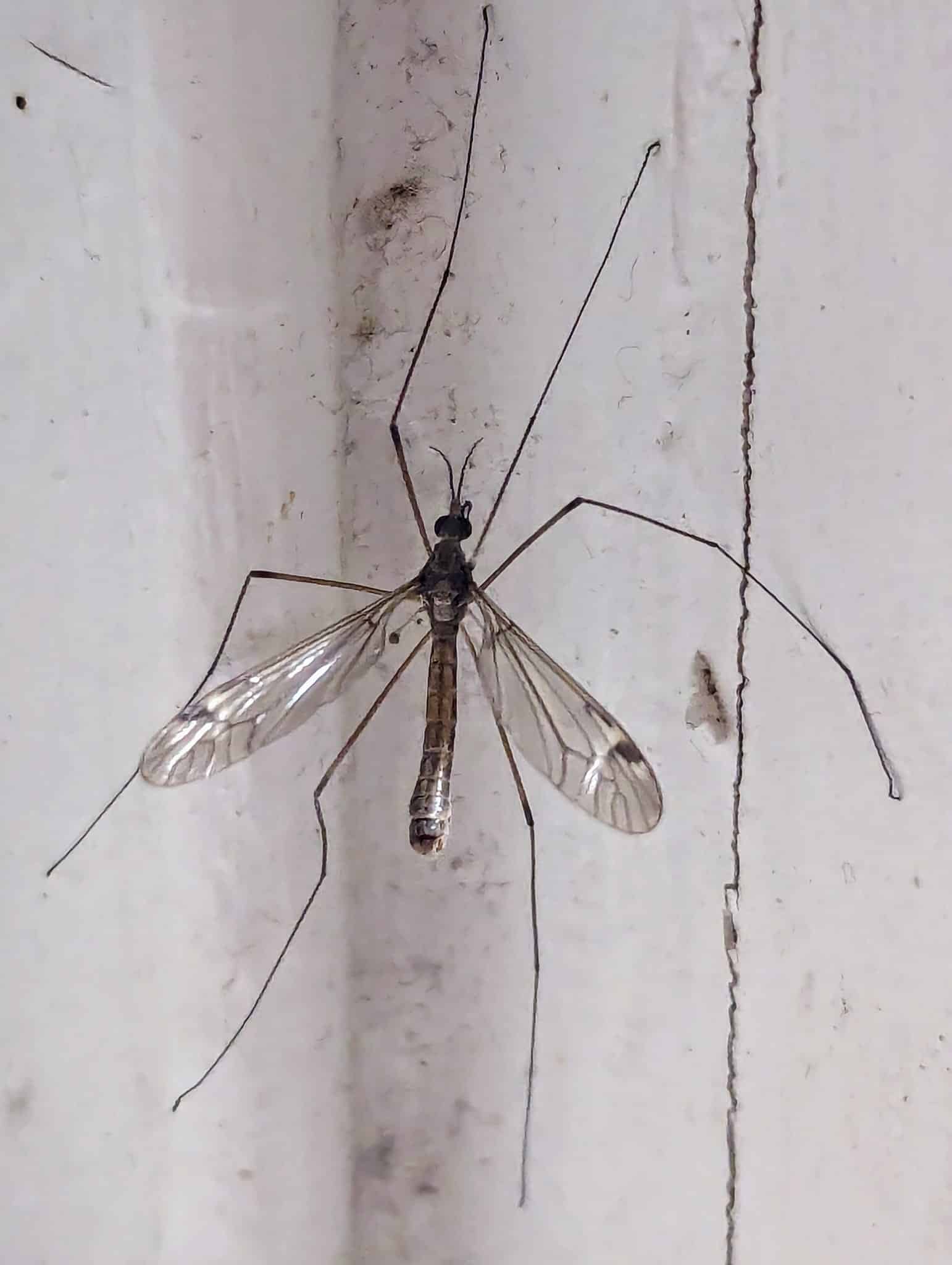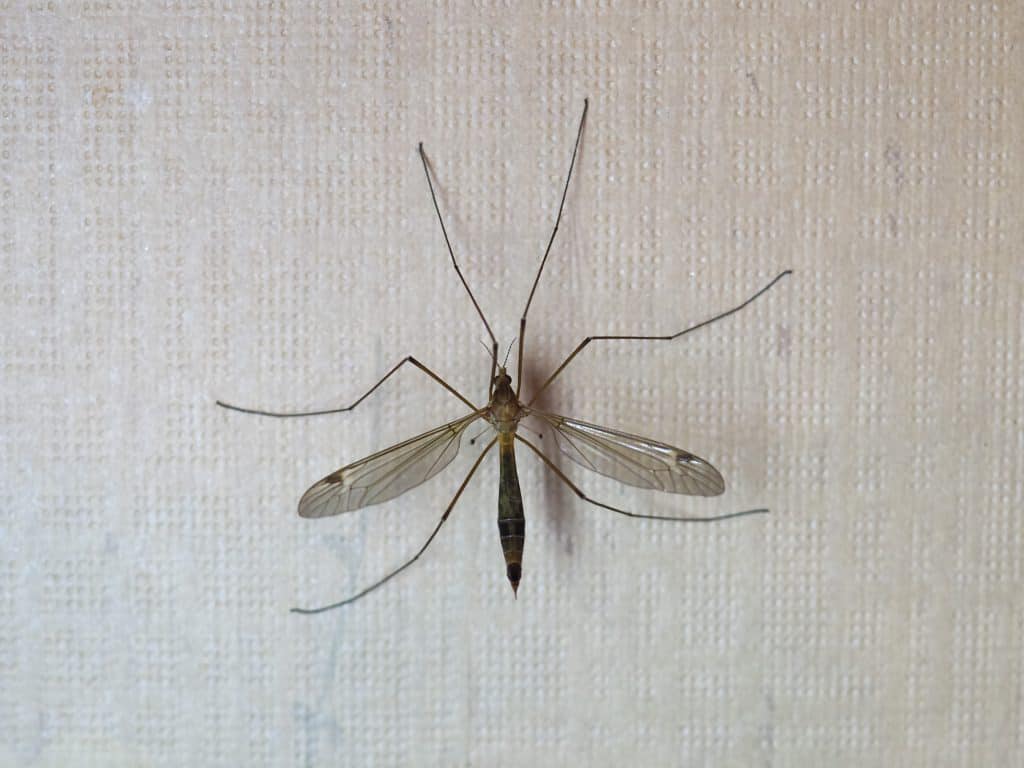Often mistaken for giant mosquitoes because of their long, slender bodies and delicate legs, crane flies are a common sight in many regions worldwide, especially during warmer months. However, unlike mosquitoes, crane flies are harmless despite the rumors.
Also, despite widespread reports on the internet, adult crane flies neither bite nor sting. So, since these insects do not directly harm humans or animals, why get rid of them?
Well, they are annoying, especially when they gather in large numbers, and their larvae can damage your lawn. Below is a comprehensive guide on how to get rid of crane flies effectively.
Do Crane Flies Damage Plants?
Crane flies are not predatory insects; they don’t have mouthpieces to do so. A significant number of adult crane flies consume minimal or no food at all. However, some can suck up liquids like honey water, or dew as they have independently developed long mouthparts that let them suck nectar from flowers.
You may wonder how crane flies survive with little to no food. They don’t need much food since they only live for a few days, dying off after a mating spree.
The bottom line is that adult crane flies are harmless to plants, but the same cannot be said about the larvae. Crane fly larvae reside in the ground and eat the roots of grasses, plants, and crops.
In large numbers, crane fly larvae can cause significant damage to lawns, turfgrass, and crops by weakening or killing the plants. During warm nights, they feed on grass blades and crowns, leaving brown patches on your grass.
Grub-eating animals like skunks and birds will also often come to your property with crane fly larvae around. While this will help control their population, they can significantly damage your lawn while at it.
Read More:
- 15 Plants That Repel Mosquitoes
- How To Get Rid Of House Flies
- How To Kill A Wasp In Your House Without Getting Stung
How To Eliminate Crane Flies
Proper crane fly control involves ensuring you kill these insects in the larvae stage, as this is when they are destructive. This section explores the different ways to eliminate these insects.
1. Examine The Problem
A crane fly issue in your lawn typically appears as patches of yellow or brown grass or even bare dirt, especially in shaded or moist areas. You may also notice damage to your ornamental grass. Therefore, if you see these signs, carefully dig up your lawn soil and inspect it for crane fly larvae.
Look for soft, greenish, grey, or tan-colored, cylindrical worm-like creatures with elongated bodies. Crane flies are attracted to moist environments and are commonly found near bodies of water, damp soil, and areas with decaying organic matter.
Therefore, a damp yard is a conducive area for these insects. The females lay eggs in moist vegetation or soil during the breeding season. You may also spot adult crane flies indoors, especially near windows, doors, or light sources.
2. Reduce Moisture In Your Property
As you know, crane flies prefer moist environments, so minimizing moisture creates less hospitable conditions for them and limits their breeding opportunities. Repair any water leakages around your home and ensure the drainage systems, downspouts, and gutters function properly.
Also, grade the soil around your home to slope away from the foundation to direct rainwater away. Furthermore, avoid overwatering your lawn and garden because excessive irrigation can create moist conditions conducive to crane fly breeding.
Excess mulch will cause too much moisture retention, so use it sparingly.
3. Biological Control
This is an eco-friendly approach for controlling crane flies. Biological control strategies disrupt the life cycle of crane flies and limit their reproduction without relying on chemical insecticides.
a) Birds
Use nature to your advantage to beat crane flies with the help of birds. Several bird species, including swallows, robins, starlings, sparrows, wrens, blackbirds, and insectivorous bird species, such as flycatchers, warblers, and nighthawks, consume adult crane flies and larvae.
Therefore, attract crane flies to your property by creating a bird-friendly environment. Below is how to achieve this:
- Install bird feeders and fill them with seeds, suet, mealworms, and other bird-friendly foods around your garden. Also, plant berry, fruit, and seed-producing native trees, shrubs, and flowers.
- Install bird baths, shallow ponds, or water features for birds to drink, bathe, and forage for aquatic insects. Keep the water clean and fresh.
- Provide birds with a place to build nests and raise their young by setting up birdhouses, nesting boxes, or bird-friendly structures. Install them at varying heights and orientations to accommodate different bird species.
- Plant dense vegetation, hedges, and evergreen trees to provide birds with an area to seek cover and shelter from predators and inclement weather.
b) Beneficial Nematodes
These microscopic roundworms parasitize crane fly larvae, effectively reducing their numbers by a minimum of 50%. Buy nematodes specifically known to target crane fly larvae. Common options are Heterorhabditis bacteriophora and Steinernema feltiae.
The best time to apply nematodes is when crane fly larvae are actively feeding in the soil, typically during the spring and fall. Apply them when the soil temperatures are between 50°F and 85°F (10°C to 29°C)
Before applying beneficial nematodes, mix the nematodes with non-chlorinated water at room temperature to avoid harming the nematodes. Apply the nematode solution evenly with a sprayer or watering can over the areas where crane fly larvae are present.
c) Regular Lawn Care
Nothing beats a properly maintained lawn when it comes to controlling crane flies. Crane flies prefer laying eggs in tall grass, so keep the grass short by mowing regularly, especially during the warmer months when crane flies are active.
Moreover, dethatch your lawn regularly to remove excess thatch, which provides an ideal habitat for crane fly larvae. Lawn aeration is another practice that helps keep crane flies at bay. It improves soil drainage and reduces excess moisture.
You must also ensure you don’t overwater your lawn and that moisture doesn’t linger on the surface.
4. Apply Insecticides
Kill crane flies with powerful insecticides like imidacloprid, pyrethroid, and neem oil, which are known to effectively control their populations by paralyzing and eventually killing them. Use insecticides cautiously because although their toxicity levels do not adversely affect humans, they can cause irritation or sickness.
5. Physical Removal
Utilize the methods below to physically remove adult crane flies from your home.
- Manual Swatting
Use a fly swatter or a rolled-up newspaper to swat the adult crane flies when you see them flying around. Proper timing, patience, and vigilance are key to a successful swatting.
- Vacuuming
Suck up adult crane flies from walls, ceilings, and other surfaces with a vacuum cleaner, then empty the vacuum bag or canister promptly.
- Trapping
You can create a simple trap using a jar with a narrow opening. Place sugar-water solution or a piece of fruit at the jar’s bottom to attract the crane flies. Once they fly in to feed, quickly cover the jar with a lid and release the flies outdoors.
Alternatively, place DIY traps made using household items, such as a bowl of soapy water or vinegar and dish soap mixture, where you frequently see crane flies. The scent will attract these insects, and they’ll get trapped.
- Bug Zappers
These devices can attract and kill flying insects, including crane flies. Therefore, consider buying one. Note that bug zappers can harm beneficial insects.
6. Install Screens
Keep adult crane flies out of your house by installing screens on your window and door frames. These screens block the entry of crane flies while still letting air inside, ensuring proper ventilation.
Choose screens with small mesh size, typically 16-18 mesh per inch, to ensure crane flies cannot go through.
Note: If you have pet doors, make sure they have flaps or covers that seal tightly when not in use to prevent pests from entering.
Conclusion
Seeing a crane fly once in a while around your home should not cause panic because they are nothing more than pesky insects. However, I advise taking action if their population increases and you notice damage in your garden or lawn. The strategies above help get rid of adult and larvae crane flies.

I’m Mike Hyle, an exterminator with 7+ years of experience handling all sorts of pests, including mice, cockroaches, bed bugs, and termites. I also write for Pest Solutions DIY blog to share my knowledge and help homeowners keep their homes pest-free. Outside work, I enjoy hunting, snowshoeing, and exploring nature. Check out my blog for helpful pest control tips!


